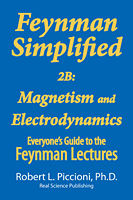In fact, many
authors
still write the equations this way. The two constants ε0 and
µ0 are called the vacuum
permittivity and the vacuum
permeability,
respectively. Their values are determined experimentally by measuring
the force between charges and the force between currents.
As we discovered in
the
prior section, Maxwell’s equations show that electromagnetic fields
propagate at velocity v, which as the equations were once written is:
v = 1/√(ε0 µ0)
Feynman says that
Maxwell
“remarked on the mysterious coincidence that [v] was the same as the
speed of light. ‘We can scarcely avoid the inference,’ said Maxwell,
‘that light consists in the transverse undulations of the same medium
which is the cause of electric and magnetic phenomena.” (We now know
that the field undulates without a medium.)
The theory of
electromagnetism first unified the concepts of electricity and
magnetism, and ultimately unified these with light. All these are
different aspects of one common natural phenomenon.


